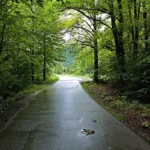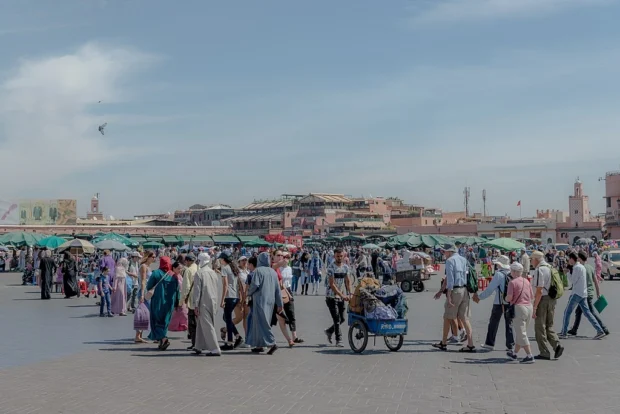Jemaa el-Fnaa is the heart of Marrakesh, Morocco, where history, culture, and daily life blend into an unforgettable scene. This lively square draws visitors from all over the world looking for local food, street performances, and a taste of Moroccan life. Nearby, you will find many guesthouses and riads perfect for staying close to the action. From the Marrakesh-Menara Airport, taxis or buses make reaching Jemaa el-Fnaa easy. The main train station and city center are within short taxi rides or a walk, depending on your energy. Around the square, you will spot many stalls serving famous Moroccan dishes like tagine, harira soup, and fresh orange juice. Jemaa el-Fnaa is a rich place packed with stories, colors, and sounds that make it a must-see when in Marrakesh.
Table of Contents
To get a fuller sense of Marrakesh beyond Jemaa el-Fnaa, this guide to Marrakesh’s culture, food, and sights offers insights into quiet alleys, historic landmarks, and local flavors that make the city special.
How to Reach Jemaa el-Fnaa Easily
Jemaa el-Fnaa lies within the old Medina, making it a pedestrian-friendly zone. From the airport, most visitors take a taxi which can take about 20-30 minutes depending on traffic. Public buses are cheaper but less direct. If you arrive by train, the Marrakesh train station is around 3 kilometers away. A quick taxi or a 30-minute walk through the city streets will get you there. For those staying in the Medina or nearby neighborhoods, simply follow the narrow alleys leading to the square – signs and locals can help. Getting lost here is part of the fun but keep a map or GPS handy, especially after dark.
Evening Vibes and Best Times to Visit
Jemaa el-Fnaa lives a double life. By day, it is busy with snake charmers, fruit sellers, and henna artists. But the real spectacle starts after sunset when the square fills with food stalls and musicians. The best time to visit is late afternoon through the evening, especially on weekdays when it is lively without overwhelming crowds. Weekends can be busier but also bring more performers. Arriving early morning shows a quieter version where you can observe locals setting up shops and preparing for the day. Weather-wise, spring and autumn offer the most comfortable temperatures to enjoy the outdoors here.
Jemaa el-Fnaa History and Cultural Importance
This square has been Marrakesh’s gathering place for centuries. It was once a marketplace for traders, a place for public storytelling, and even a spot for royal announcements. The name means “Assembly of the Dead,” which some say refers to the historic public executions here during distant times. Others believe it reflects the square’s role as a place where people meet to share stories and news. UNESCO added Jemaa el-Fnaa to their Intangible Cultural Heritage list in 2008, recognizing its deep roots in Moroccan culture and oral traditions. For centuries, performers like griots and magicians have entertained crowds here, keeping ancient tales alive.
Myths and Stories You Won’t Hear Elsewhere
One quirky fact many miss is the legend about the snakes. While snake charmers are common now, old stories say that snakes were once used to warn the city of approaching danger. Another tale speaks of secret messages hidden in the patterns of carpets sold around the square, passed only to trusted buyers. These legends add layers of mystery to your visit and show how Jemaa el-Fnaa is not just a market but a living storybook.
Booking Guided Tours and Reservations
While wandering Jemaa el-Fnaa without a guide is possible and fun, joining a local guide can enrich your experience. Many tours offer explanations about the food stalls, history, and crafts. Booking a guided evening tour is popular because guides know the best food stalls and safe spots to enjoy performances. Reservations for large groups or special experiences like cooking classes or storytelling nights are advisable. Many tour companies provide online booking options for convenience. Remember, wandering is part of the charm but a guide can help uncover hidden gems and avoid tourist traps.
Local Flavors You Must Taste Nearby
- Try traditional Moroccan tagine made with lamb, chicken, or vegetables at food stalls around the square.
- Sample harira, a rich tomato and lentil soup, especially popular during Ramadan.
- Freshly squeezed orange juice from street vendors provides a refreshing break.
- Snack on sweet Moroccan pastries like chebakia or sellou for a taste of local sweets.
- Mint tea served in small glasses offers a true Moroccan hospitality experience.
Tips for a Safe and Enjoyable Visit
Keep in mind that Jemaa el-Fnaa is crowded and lively, so watch your belongings carefully to avoid pickpocketing. It is best to carry small bills for shopping or eating to avoid problems with change. Be polite but firm if you do not want to buy from street vendors. Dress modestly respecting local customs, especially if visiting during religious holidays. Taking photos is welcome but always ask permission from performers and locals first. Lastly, keep hydrated and take breaks in nearby cafes if the energy of the square becomes intense.
Official Jemaa el-Fnaa Information and Resources
For updated events, cultural programs, and visitor advice, the official website of Marrakesh’s Medina and Jemaa el-Fnaa is a valuable resource. It provides details on festivals and how to respect the traditions of this UNESCO site. Visit their page at Visit Marrakesh Official Site for the latest information.

A digital nomad exploring cities across the globe, with a passion for local street food and hidden cafes.
- Jemaa El Fnaa 4 by Jonjobaker on Wikimedia Commons – cc by-sa 4.0
